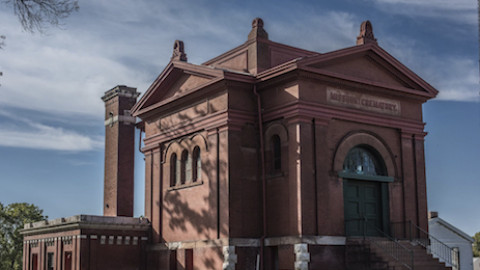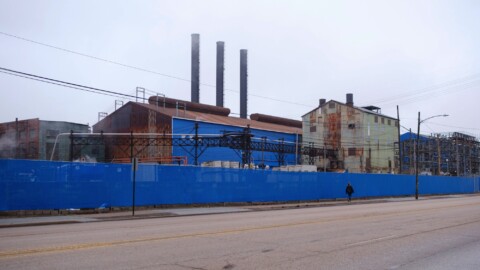photograph by Diane Cannon Piwowarczyk
Hamilton Heights is a neighborhood of vast potential. In the 1940’s, this area experienced its “golden days”, when the turn of the 20th century homes possessed a not too tired character, celluloid beamed brightly in the local movie theaters, and streetcar lines serviced the main business corridors. Today, much of that original housing stock has deteriorated (about 45% of the existing homes were built before 1940 and another 45% after 1980), though what remains offers many possibilities.
photograph by James Palmour
photograph by Dan Henrichs Photography, St. Louis
photograph by Chris Naffziger
photograph by Jason Gray
To anyone that grew up in Hamilton Heights during the glory days, a familiar presence would have been the streetcars whose lines nearly encircled the neighborhood. With the population explosion of nearby Wellston, residents of Hamilton Heights must have enjoyed the abundance of shopping and entertainment that bloomed along both sides of Easton Avenue (now Dr. Martin Luther King Jr. Drive). During this height, four street car lines and three bus lines served the area, and the Wellston Loop shopping district was described by local press as being as crowded as “Union Station anytime”. Even as population decline occurred, the streetcars remained central to the ethos of Hamilton Heights, so much so, that the last stop, upon the last remaining streetcar line in St. Louis, was the Wellston Loop station. It should not be surprising then that transportation has had as much to do with the neighborhood’s success as it does with its decay.
photograph by Diane Cannon Piwowarczyk
photograph by Susan Price
photograph by Jackie Johnson
photograph by Robert Williams
In May of 1966, the St. Louis Public Services Company ceased running all streetcars in the city, and ended a form of transportation more than a century old. What’s more, most of the ancillary lines that served the suburbs and beyond also ceased running (somewhat strange considering that streetcars enabled the very existence of most of the inner-ring, STL suburbs). Nonetheless, the majority of the streetcar lines were either immediately or else gradually converted over into bus lines, so this change, although sad, was not responsible enough for the downturn that followed. The Federal Highway Act of 1956 passed legislation for the planned construction of an interstate highway system to connect all parts of the continental United States. When it came to cities, not a lot of care was paid to how the road would impact existing communities, especially so given the consensus was that the mere construction of the highway would be as if a cornucopia of economic opportunity was being handed to residents. Of course, this was not always so, and is the reason why we have Interstate 70 carved through Downtown St. Louis. When neighborhoods like The Hill, Lafayette Square, and Mount Pleasant were cut off from themselves, the effects were sometimes severe. All of that said, there is no interstate highway that comes anywhere near Hamilton Heights, which illustrates another way that the highway system impacted communities: isolation=desolation.
photograph by Robert Williams
photograph by James Palmour
photograph by Jason Gray
photograph by Ann Aurbach
At the start of this article, I wrote that about 45% of the existing homes were built before 1940 and another 45% after 1980. This is significant, and shows that between these dates, Hamilton Heights, once as crowded as the world’s largest passenger train terminal, experienced something extraordinary that altered its fortunes in a real hurry. So what happened? Certainly, “White Flight”, racially motivated real estate and building loan practices, and general rust belt decline all contributed huge impacts, but another major dent was caused due to how people commute through the area. The road that forms the northern border of Hamilton Heights, Dr. Martin Luther King Jr. Drive, was known as Easton Avenue during the streetcar days, and before that as St. Charles Rock Road, or simply, Rock Road (a reference to the fact that it was macadamized in 1865). This road connected the early European settlement of St. Louis to the early European settlement of St. Charles, and dates back to the 1700’s. When the interstate was built, this traditional route was made obsolete, and so the population explosion that had been occurring in nearby Wellston naturally followed the construction of the new highway, ever further out and away from the city. This is a process that continues today.
photograph by Susan Price
photograph by Ann Aurbach
photograph by Jeff Phillips
There is hope for Hamilton Heights. As evidenced throughout this page, there is a strong community of people living in the area, and they want to see change happen again. A committed neighborhood group, the Hamilton Heights Neighborhood Organization, Inc. is dedicated to improving life and creating opportunities for residents. Throughout this Flood, we encountered people proud of their neighborhood’s heritage, but frustrated by its current condition. That these people exist here is extremely promising, and combined with a very unique business infrastructure left over from the streetcar era, I do feel confident that things in Hamilton Heights really could begin to change for the better.
photograph by Ryan Stanley
photograph by Theresa Harter
photograph by Theresa Harter
photograph by Dan Henrichs Photography, St. Louis
Our end point for Photo Flood 30 was not the one pictured on the map, but rather the fantastic, Jaden’s Diner, where we ate for Photo Flood 19. This is the first restaurant that we have ever eaten in twice, and it is totally worth repeat visits.
photograph by Jason Gray































